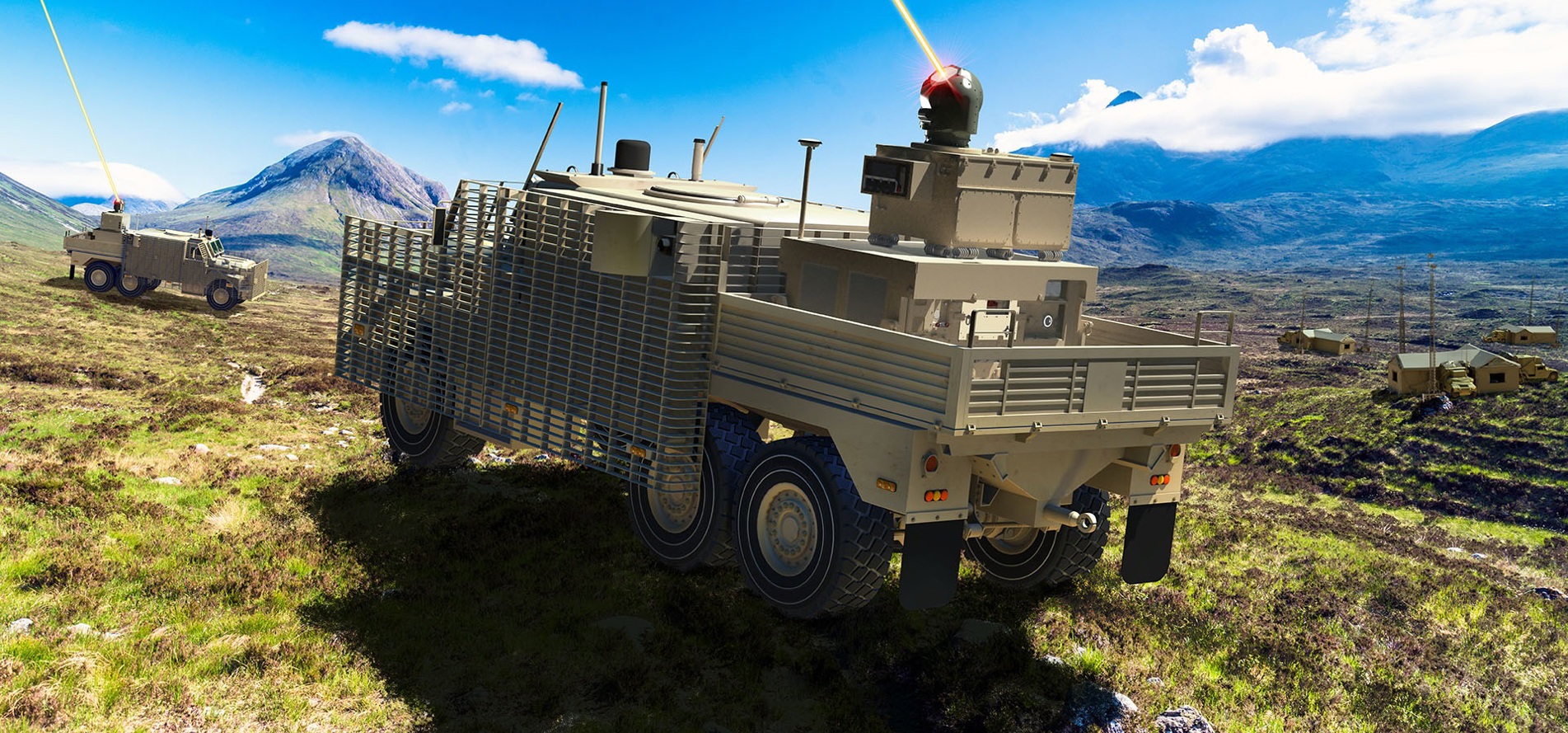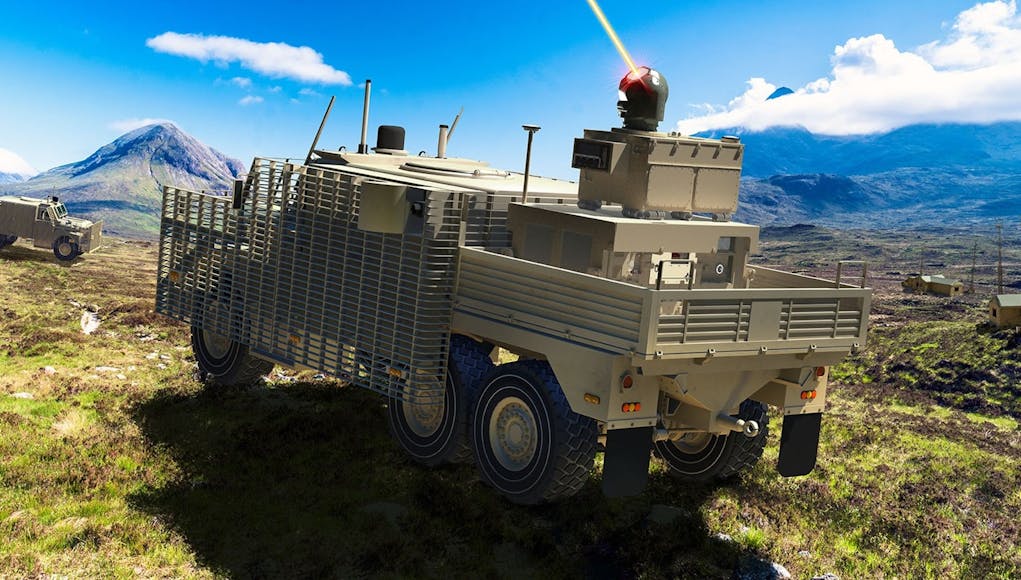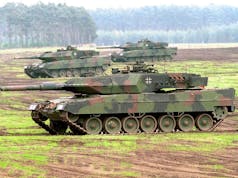The Ministry of Defence has awarded three contracts worth £72.5 million to UK industry partners to develop and produce demonstrators as part of the its Novel weapons programme.
Known collectively as Directed Energy Weapons (DEW), these next-generation technologies could revolutionise the battlefield and help to reduce the risk of collateral damage.
“Powered by electricity they operate without ammunition. This reduces operating costs whilst increasing platform endurance and providing unprecedented offensive and defensive flexibility to soldiers on the frontline. The three contracts will deliver two laser DEW demonstrators and one radio frequency DEW demonstrator.
Two of the demonstrators will be delivered to the Army. The chosen platform for the laser DEW that will detect and counter unmanned aerial vehicles (UAV) as well as land-based targets, will be Army’s Wolfhound, a six-wheeled variant of the acclaimed Mastiff.”

A news release states:
“The radio frequency demonstrator will also be hosted on a MAN SV truck and will enable to detection and tracking a variety of air and land targets before disrupting or damaging them using electromagnetic energy. These innovative capabilities will undergo user experimentation from 2023 to 2025. This will focus on operation and maintenance and will provide invaluable knowledge, information and experience to assess whether DEW can be fully embedded on other Defence assets in the future.”
These weapons systems, which are being developed by a consortia led by Thales UK, “further reinforces the commitment by us and the Ministry of Defence to develop novel technologies”, say the MoD.
“This marks a significant step towards the use of DEWs to enhance the capability of future soldiers and ensure that they will continue to have the best equipment available.”
We also reported yesterday that the Ministry of Defence have announced that Thales will develop and fit a directed energy weapon to a Type 23 frigate in order to test the system at sea.













Right so if this is fundamentally the same system between the truck and Frigate I would presume it is somewhat less complex and has lesser aims than what is being worked on under the Dragonfire programme assuming that is still active. One presumes they need something quick to deal with the drone threat and provide a minimum defence ASAP..
The technology is quite old now so it’s about time it was fielded
Could this be linked to the army testing new highbrid powertrains on an adapted I think jackal chassis?
Sounds plausible doesn’t it.
Deadly laser weapon mmmmmm, in the current budget and force structure planning, it will be a small maglight with the end painted red.
Bit like I have in my garden, perhaps I should become a defence supplier 🏴☠️
250 red laser pointers gaffer taped onto a broom handle?
Better than Ajax, you can use a broom handle 😂
Oooh! Cutting!😉
Quick! give the sailors a laser pen. https://www.youtube.com/watch?v=NIOh9-RoAaE
Actually modern fibre optic laser arrays are not far off that. Take a load of industrial lasers used to cut things like steel… Put them together in an array and fire them off. No need to worry about getting the beams in phase… Power over complexity…
The Problem is power and heat management and a maximum upper Power limit…oh and range which is a few Kms.
Recieve? “i” before “e” except after “c”!
Actually, Mike, you and I could have a field day pointing out all the errors by the posters on this site. But that would be churlish. Post away, guys (and gals, if there are any?). The beauty of our language is w cn lwys ndrstnd wht ppl r wrtng, hwvr bdly thy spll!
Quick way to cook your Rat packs and that’s it
I wonder will the new wonder weapon be deadly in the colloquial or literal sense. Or both.
Following the Israelis, perhaps we could give it a catchy name, like InvisiDome and after a period, one of the mobile telephony companies might sponsor it. Naming it, Biff Baff maybe?
I prefer Death Star myself straight to the point.
I like where you’re going with that.
However, the Death Star was capable of destroying planets,
so you might be setting expectations just a touch high.
Maybe Duke of York? Since QEII and P of W seem to have worked.
If you exclude the fact of no air wing, of any size. Makes them great
practice targets for N. Korea.
A good step forward in technology, but my question about DEWs is how long does the beam have to stay on the target to have a (destructive) effect ? fast-moving targets such as missiles may not get damaged enough, quickly enough to stop their attack from being effective.
A number of factors come into play. If we are talking lasers, then its the spot’s diameter and intensity that is crucial. The larger the diameter, more energy is spread out. Similarly if the beam’s intensity is disrupted by reflective particles in the air, then there will be less energy reaching the target. The next factor would be the material construction of the target. If its a small drone with a fibreglass fuselage a 50kW laser will burn through that in less than a second. If the target is a missile that uses a thin aluminium alloy fuselage. Then the spot will have to be centred for longer to make sure it burns through. This is why you preferably have a much higher wattage laser for CIWS (>100kW). As the higher the beam intensity, the faster it can burn through the target’s skin. With a laser you will be using it in the pulse mode, as this has a higher energy density when hitting the target compared to a continuous wave mode laser. Therefore the time it needs to stay on the target is much reduced.
If we are talking a highly directional microwave weapon. Then these are pretty much just the transmitter side of a high powered radio or radar. The idea is to overwhelm the drones control signal with white noise, i.e. act as a jammer. As the further away the drone is from the operator, the weaker the drone’s control signal gets. Or induce electromagnetic interference (EMI) on the drones ECU and cause a system overload and damage. Thus making the drone uncontrollable. Again how effective this is, is dependent on how tight the transmitted beam is and the effective radiated power of the transmitter. In the past this used to be done with Yagi aerials, but today you can achieve better results with an electronically phased array. The amount of time required to disable the drone will also be dependent on the drone’s construction and how much EMI protection the ECU has.
Presumably laser CIWS will be hopeless against hypersonic anti-ship missiles for a great many years into the future. These missiles must surely have very good thermal protection in order to endure the intense atmospheric heating caused by travel at high mach numbers?
Realistically hypersonic missile’s spend the majority of their time above 80,000ft. In the terminal phase when they dive onto their target, as the air gets thicker, to counteract the increasing temperature, the missile will start to slow down to below Mach 5. This will make sure the elevated temperatures that hypersonic speeds generate doesn’t create a plasma sheath. The plasma will effectively block both RF and optical sensors.
It also means the missile can use a thinner skin as it won’t need to handle these temperatures for very long. Therefore, the weight can be used for fuel or explosive etc.
The missile may use an ablative coating on the leading edges, as this will be the areas that heat up the fastest and highest. The rest of the missile will kept relatively light, as the additional weight due to thicker skin will eat into the achievable range. So in theory a 100kW+ laser should be able to burn through the missile’s skin pretty quickly.
Thank you for taking the time to respond in detail to my question. Your reply is very interesting and informative.
These systems are always talked about being used against the enemies assets or incoming ordinance. I wonder how far away we are from target enemy troops or is that taboo Geneva convention stuff? I know China has been accused of dazzling US pilots in North Africa with lasers.